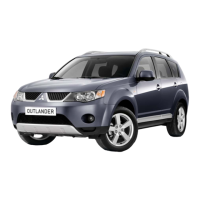
Do you have a question about the Mitsubishi MOTORS Outlander 2018 and is the answer not in the manual?
| Brand | Mitsubishi MOTORS |
|---|---|
| Model | Outlander 2018 |
| Category | Automobile |
| Language | English |
Describes the location and function of various instruments and controls in the vehicle's cabin.
Details the various interior components and features, including seats, lighting, and storage.
Explains the features and layout of the vehicle's luggage compartment.
Covers the exterior components visible from the front of the vehicle, including lights and sensors.
Details the exterior features visible from the rear of the vehicle, including lights and the liftgate.
Explains the meaning and recommended actions for various warning lights that may appear while driving.
Provides troubleshooting steps for common issues encountered with the vehicle's systems.
Guides the user on selecting the correct type of fuel and explains related considerations.
Provides instructions and safety precautions for refueling the vehicle's fuel tank.
Discusses the impact of vehicle modifications and racing on performance, safety, and warranty.
Details the adjustment and features of the vehicle's seats, including front, second, and third row configurations.
Explains the proper usage, adjustment, and safety precautions for seat belts.
Describes the function, components, and safety precautions related to the vehicle's airbag system.
Provides guidelines for the initial period of vehicle use to ensure optimal performance and longevity.
Explains the different types of keys, their functions, and security features like the immobilizer.
Details the anti-theft system that prevents unauthorized starting of the vehicle.
Explains how to use the remote control transmitter for locking, unlocking, and other features.
Covers the operation and features of the keyless entry system using the F.A.S.T.-key.
Describes the operation of the power door locks and liftgate, including lock-out protection.
Explains how to use the child safety locks to prevent unintended rear door opening.
Explains the operation of the power liftgate, including automatic and manual modes.
Details the Blind Spot Warning system's functionality and limitations.
Illustrates the areas around the vehicle where the BSW system can detect other vehicles.
Describes the Rear Cross Traffic Alert system's functionality and limitations.
Shows the areas around the rear of the vehicle where the RCTA system can detect approaching vehicles.
Explains the Lane Departure Warning system's functionality and limitations.
Explains how to configure the Lane Departure Warning system to different modes.
Covers the tire pressure monitoring system's warning lights and indicators.
Covers tire maintenance, including checking pressure, tread wear, rotation, and replacement.
Explains the importance of proper tire inflation and how to check it.
Provides guidance on replacing tires and wheels, including cautions for TPMS sensors.
Shows the location of fuse blocks and provides a fuse load capacity table.
Guides the user on how to safely replace a blown fuse.
Provides instructions for replacing various exterior and interior light bulbs.
Explains how to activate, set, and deactivate the cruise control system.
Details the operation, limitations, and settings of the Adaptive Cruise Control system.
Offers essential advice for safe driving, covering vehicle handling and awareness.
Provides tips and recommendations for maximizing fuel efficiency through driving habits.
Emphasizes the severe risks of driving under the influence of alcohol or drugs.
Details the importance of using the correct floor mats and securing them properly to prevent pedal interference.
Outlines essential checks and preparations before starting the vehicle to ensure safety.
Explains how to determine and manage vehicle load capacity, including cargo and roof loads.
Provides essential information and precautions for safely towing a trailer.
Describes the air vents and how to adjust airflow and direction for driver and passengers.
Explains the operation and features of the automatic climate control system.
Offers advice for efficient and effective operation of the air conditioning system.
Provides guidance on what to do when the vehicle breaks down on the road.
Details the procedure and safety precautions for jump-starting the vehicle's engine.
Explains the causes and steps to take when the engine overheats.
Provides a step-by-step guide for safely changing a vehicle tire.
Explains the correct procedures and precautions for towing the vehicle.
Offers advice for driving in challenging conditions like snow, sand, mud, or water.
Outlines general safety precautions and recommendations for vehicle maintenance.
Details how to open, close, and secure the vehicle's engine hood.
Provides a diagram identifying key components within the engine compartment.
Explains how to check and refill engine oil and replace the oil filter.
Guides on checking and adding engine coolant, including radiator cap safety.
Covers tire maintenance, including checking pressure, tread wear, rotation, and replacement.
Explains the importance of proper tire inflation and how to check it.
Provides guidance on replacing tires and wheels, including cautions for TPMS sensors.
Shows the location of fuse blocks and provides a fuse load capacity table.
Guides the user on how to safely replace a blown fuse.
Provides instructions for replacing various exterior and interior light bulbs.
Offers information on uniform tire quality grading and safety defect reporting.
Details how to inform the NHTSA and Mitsubishi Motors about potential vehicle safety defects.
Provides crucial information and steps to follow in the event of a vehicle accident.
Emphasizes the importance of using genuine Mitsubishi parts for repairs and maintenance.
Explains where to find essential vehicle identification and labeling information.
Shows the location of the engine model and serial number stamps.
Details the information found on the tire and loading placard, crucial for safe operation.
Lists the exterior dimensions of the vehicle.
Provides specifications for various vehicle weight limits, including GVWR and GAWR.
Lists key engine specifications for different models, including displacement and spark plug details.
Covers tire sizes, wheel specifications, and lubricant recommendations.
Details the fluid capacities for various vehicle systems like fuel, engine oil, and transmission.











